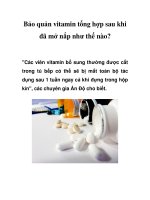Vitamin tổng hợp
Bạn đang xem bản rút gọn của tài liệu. Xem và tải ngay bản đầy đủ của tài liệu tại đây (2.2 MB, 50 trang )
12.2 Vitamins
chapter 19(4th ed.); chapter 17(3rd ed.)
MICRONUTRIENTS 2
Vitamins are nutritionally important organic
compounds.
Often coenzymes or cofactors for enzyme function.
Vitamins form biochemically through the life
processes of the plants and animals we eat.
Plants and animals synthesize vitamins.
Originally it was thought these necessary
compounds were all amines. Since they were vital
to our health they became known as
“vital amines”, ie. vitamines.
When it was discovered that some were not
amines, ie. not ' --ines', the name was changed to
vitamins.
The fat - soluble vitamins are much more soluble in
fats, hydrocarbons and similar solvents than in water
Vitamins A, D, K, E
Water- soluble vitamins are much more soluble in
water than in 'organic' solvents.
C, B complex (B1,2,3,6,12), Pantothenic acid(B5),
Biotin(B7), Folate(B9)
Vitamin Requirements
Name(Letter)
Water-Soluble
Thiamin (B1)
Riboflavin (B2)
Niacin (B3)
Pantothenic acid (B5)
Pyridoxine (B6)
Biotin (B7)
Folic
acid (B9) Cobalamin
(B12) Ascorbic acid
RDI
1.5 mg
1.7 mg
2 mg
10 mg
2
mg 0.3
mg 0.4
mg 6
µg 60
mg
Vitamin Requirements
Name(Letter)
RDI
Oil-soluble
Retinol (A)
Calciferol (D)
Tocopherol (E)
Phylloquinone (K)
5000 IU
400 IU
30 IU
70 µg
Vitamin levels in foods or supplements are
sometimes stated in Retinol Equivalents (RE's) or in
International Units (IU's).
RE's and IU's represent not only the quantity of the
vitamin itself, but the total amount of the vitamin and
its physiological equivalents that can be converted
into or used as the vitamin.
Eg. for Retinol: 3 IU = 1 RE = 1µg (= 6µg carotene)
or
10µg calciferol = 400 IU vit.D
Free Radicals - the Metabolic Oxidizers
Free radical = unpaired electron ∴very reactive
.
OH
OH
.
OH
OH
Oxygen radicals: Hydroxy (HO•) / Peroxy (HOO•)
An antioxidant is a chemical so easily
oxidized itself that it protects others from oxidation.
OH
and / or
Double Bond
eg. Vitamin A
Phenol
eg. Vitamin E or C
Repel the Enemy !
Vitamins - Some Generalities
• Fat-soluble vitamins can be accumulated in body
tissue/organs, eg. liver. Often there can be serious
metabolic consequences when ingesting 'megadoses', ie.10 - 100X the RDI.
• The water-soluble vitamins are often destroyed by
heat/water in the cooking process; also by
prolonged storage. Since they are excreted there
is
usually no danger from 'overdosing' (vit B6!).
• Diet-related deficiencies do occur in vegans, the
elderly and alcoholics
Fat-Soluble Vitamins ( A & D)
H3C
C H3
C H3
C H3
CH 2 OH
C H3
Retinol (Vitamin A)
H 3C
CH3
CH2
HO
Cholecalciferol (Vitamin D3)
CH 3
C H3
Fat-Soluble Vitamins ( E & K)
H3C
CH3
HO
CH3
CH3
CH3
CH 3
O
α-Tocopherol (Vitamin E)
H3C
CH3
O
CH3
CH
CH2
O
C
CH3
Phylloquinone (Vitamin K)
H
CH3
3
Water-Soluble Vitamins ( B1 & B5)
+
H2N
S
N
CH2
N
15
H3C
CH2
N
H3C
OH
Thiamine (B1)
HOH2C
H3C
O
CH3
H2
C
H2
C
CH
N
H
C
H2
COOH
OH
Pantothenic Acid (B5)
Water-Soluble Vitamins (B2 & B6)
Water-Soluble Vitamins (B3,B7,C &?)
O
COOH
NH
HN
Biotin(B7)
N
Niacin(B3)
S
HO
O
C
H2
H2
C
COOH
O
HO
HO
C
H2
H2
C
OH
Ascorbic Acid(C)
HOCH2CH2N+(CH3)3
Choline
Natural = Ascorbic Acid = Synthetic
Water-Soluble Vitamin (B9)
Water-Soluble Vitamin(B12)
Cobalamin
A - Retinol
Uses: vision pigment, good anti-oxidant (heart
disease? cancer?)
Deficiency: night blindness, (infant mortality)
Excess: blurred vision, teratogenic for pregnant
women, serious liver disease
Sources: highly coloured vegetables, liver, egg
yolks, fish liver oils
D - Calciferol
Uses: regulates absorption of calcium & phosphorus
Deficiency: rickets (bone deformation)
Excess: damage to kidneys/tissue due to Calcium
'deposits'
Sources: eggs, liver, fish oils, fortified milk, sunshine
E - Tocopherol
Uses: excellent anti-oxidant (protects cell
membranes)
Deficiency: rare; (anemia, edema in infants)
Excess: very safe below 800 IU/day
Source: vegetable oils, green vegetables,
nuts/seeds, wheat germ, meat
K- Phylloquinone
Uses: essential cofactor in blood clotting
Deficiency: rare, (bruising/bleeding in infants)
Excess: dangerous if taking anti-coagulants
Sources: green leafy vegetables (spinach, kale)
B1- Thiamin
Uses: necessary for carbohydrate metabolism
Deficiency: nervous system deterioration (beriberi),
esp. in Far East because of milled rice
Excess: not known
Sources: lean meat, legumes, whole grains, in
'fortified' flour since 1940s
B2 - Riboflavin
Uses: cofactor in much metabolism
Deficiency: poor wound healing, breakdown of
tissue in mouth/nose
Excess: not likely (yellow urine!)
Sources: milk, organ meats, fortified cereals
![[Tong Hop] NguPhap 01-12](https://media.store123doc.com/images/document/13/nu/kr/medium_krl1359119206.jpg)








